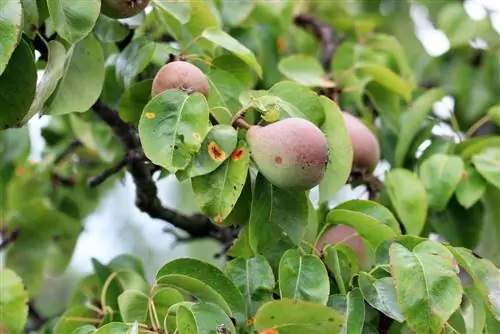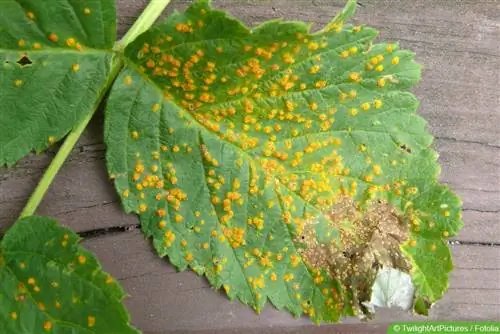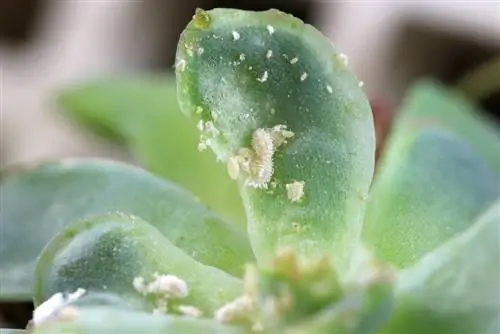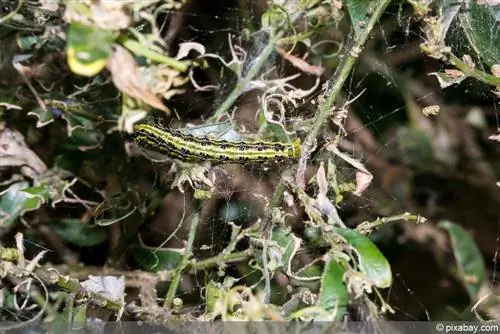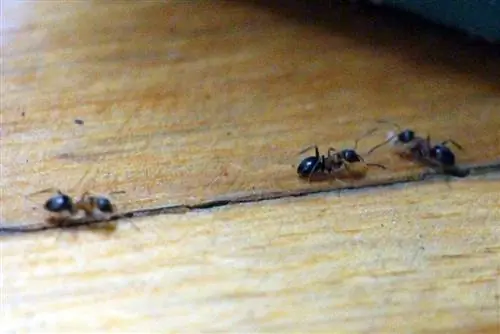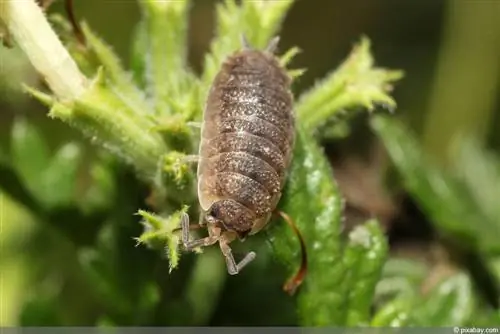- Author admin [email protected].
- Public 2023-12-17 03:39.
- Last modified 2025-06-01 06:48.
The pear rust is a fungus from the order of rust fungi that attacks plants of the Pyrus (pear) and Juniperus (juniper) species. What is unique about the fungus is the annual change of host, because juniper plants are attacked over the winter, while pears are at the mercy of pear rust in the summer. To put an end to the fungus, special sprays are available that work effectively against the infection.
Infection chain of the pear grid rust
Pear rust (Gymnosporangium fuscum) is a fungal disease that undergoes a unique course throughout the year and changes hosts several times during this time. This process is called an infection chain, which describes exactly which plant species are affected by the rust fungus and when:
- Winter to early spring: the juniper species Juniperus chinensis (Chinese juniper) and Juniperus sabina (sade tree), rarer Juniperus scopulorum (Rocky Mountain juniper)
- Spring to early autumn: pear trees (bot. Pyrus), rarely quince (bot. Cydonia oblonga)
The spores specifically attack the juniper trees and bushes of the species mentioned and spread throughout them. The infection manifests itself in knotty branch thickenings and large spore deposits. These are as follows:
- Color: orange
- Consistency: rubbery, bile-like
- protrude in individual thickenings
- get slimy over the year
The spore deposits of Gymnosporangium fuscum are easy to recognize and through these the fungus attacks its next target, the pear trees. Interestingly, the juniper plants are not damaged by the fungus, they only serve as a kind of intermediate host. Basidiospores are formed which, from spring onwards, are distributed by winds within a radius of 500 meters and settle on the leaves of pear trees. There they begin to infect the bulb and thus continue the chain of infection:
- Top of leaf becomes spotty
- Spots are orange-reddish
- Stains get bigger over the months
- Summer spores are formed, which infect the tree even more severely
- now pollinator insects such as bees are attracted by the formation of false nectar
- the spores adhere to the animals and carry them further
- In late summer the fungus spreads to the underside of the leaves
- up to 1.5 centimeter large, oval spore beds in a brownish color are formed
- these break open at the beginning of winter and spores are released, which in turn attack juniper plants
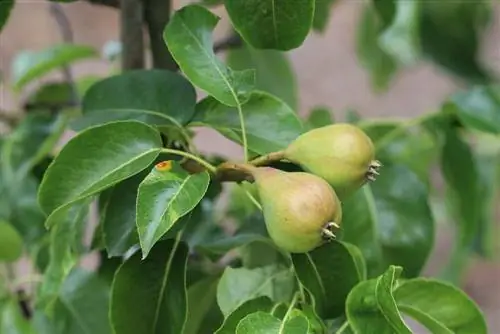
Through this chain of infection, the rust fungus can easily maintain itself and use every season to its advantage. This development must be taken into account when combating pear rust, as this is the only way to effectively combat the infestation. Young pear trees in particular can have their growth severely restricted by the rust fungus, while older specimens are only weakened. The result of this is often stunted growth that intensifies over the years, resulting in a poor harvest. However, do not confuse the infestation by the fungus with the pear pox mite, which has a similar damage pattern, but without the spore deposits.
Tip:
Even if your pear is covered in pear rust from top to bottom, you shouldn't just throw the fruit away after harvesting. The fungus only affects the leaves of the tree and not the fruits, which can still be eaten and pose no threat to your he alth.
Prevention
Fighting pear rust after pear trees have been infested is extremely laborious and difficult, so you should contain any possible infestation as early as possible. If the chain of infection described above is broken, the spores will not be able to identify the trees and your pears will be safe without much effort. There are different methods available for prevention:
Treat intermediate host
So that the spores cannot spread further, it is necessary to contain the infestation and prevent the spores from rising into the air again from spring onwards. For this reason, as soon as there is a juniper of the above species in your garden, you should check it for the fungus. If it shows the characteristic growths, you should thoroughly remove all affected areas. Simply remove these with clean garden or pruning shears.
Remove intermediate host
The complete disposal of the host is extremely effective, especially if it is heavily infested. If the infected juniper is removed from the immediate vicinity of the pears, the infection can be largely contained. But always make sure that even distant junipers can still spread their spores, so it is possible to also remove the pear tree so that the spores no longer multiply via the summer host.
Replace intermediate host
If you don't want to do without a juniper in your garden, you should choose another species that is not susceptible to rust fungus. These include:
- Commune juniper (bot. Juniperus communis)
- Gray shrub juniper (bot. Juniperus media 'Hetzii')
- Coastal Juniper (bot. Juniperus conferta)
- Virginia juniper (bot. Juniperus virginiana)
- Scaly juniper (bot. Juniperus squamata)
- Creeping juniper (bot. Juniperus horizontalis)
Alternatively, you can also choose pear varieties that are not as susceptible to the fungus:
- Condo
- Countess of Paris
- Stuttgart Goat Hirtle
- Upper Austrian wine pear
- Trevoux
- Gellerts
Although these pear varieties could still be affected by pear rust, they are much more resistant to Gymnosporangium fuscum and therefore require a longer time to become infected. Of course, replacing the juniper species is more effective.
Plant strengtheners
It is advisable to treat pears with plant tonics from the first leaves emerge in spring. Horsetail extract is best suited for this, which you can purchase from manufacturers such as Neudorff or Aries. If you want to make the extract yourself, you can do that too. This home remedy is the only one that works effectively to prevent pear rust:
- Ingredients: 10 g dried or 100 g fresh field horsetail (bot. Equisetum arvense) per 1 l water
- cut the blades of grass into small pieces
- put these in a pot with water
- Soak for 24 hours
- then bring to the boil for 30 minutes
- then pour through a sieve into another container
- mix the decoction with water in a ratio of 1:5
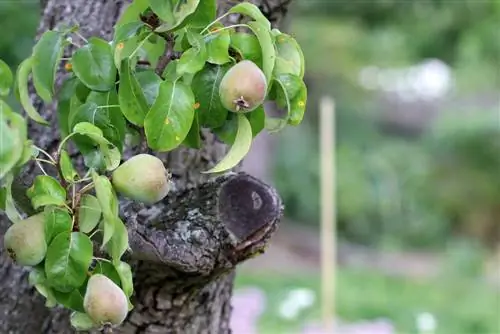
The finished extract can be stored properly for several months. Spray the pear trees with these four times at intervals of one to two weeks.
Reduce nitrogen
Use less fertilizers that contain a lot of nitrogen. These weaken the pears over a long period of time and thereby enable an infection that strikes more quickly and leaves the trees defenseless against the fungi.
Remove leaves
If your pear tree has been infected by the fungi, you should remove all leaves as quickly as possible and dispose of them in the compost. The fewer weakened leaves there are on the tree, the stronger the plant is and the risk of the infestation spreading rapidly is prevented. Don't worry, you can compost the discarded leaves as the spore stores are empty over the winter.
Tip:
If one of your neighbors has a juniper in their garden, you should definitely talk to them about possible disposal or treatment if the plant is affected by pear rust. This is the only way you can prevent a possible infection.
Sprays
Once pear rust has attacked a pear tree, it is stubborn and difficult to control. Home remedies do not work at all on this rust fungus and for this reason you have to switch to ready-made sprays. Since 2010, there has only been one fungicide on the market for home gardeners that works against rust fungus:
- COMPO Duaxo Universal mushroom-free
- available in 75 and 150 ml
- Cost: 12 - 17 euros
This universal fungicide can not only be used against pear rust, but also for other cultivated plants such as roses or herbs. This is administered to the tree in good time before the spores infest it, meaning they no longer have a chance of infecting the pear. A big advantage of the product is the depot effect, which protects the tree over a longer period of time. Use the remedy as follows:
- mix 10 ml of the product with 1 l of water
- fill the mixture into a squeeze bottle
- shake these
- spray the plants thoroughly in the evening
- the leaves should not be wet
- don't spray when it's windy, it could get in your eyes
- make sure to treat the undersides of the leaves thoroughly
- thus increasing the effect of the spray
- you should also be careful not to splash near water
- the fungicide has a harmful effect on aquatic life
An alternative to this are sprays against scab, such as Pilzfrei Ectivo from Celaflor. This should only be used for prevention.

